
https://my.vmware.com/web/vmware/free#desktop_end_user_computing/vmware_player/5_0
In the VMs-S214 window, right-click the empty space and click New, Folder. Name the folder "YOUR NAME VMs" replacing YOUR NAME with your own name.
Enter the name and password given out in class.

Download the Windows 2008 Server virtual machine. Most students are using the VMware version. It is a single-file 7-zip archive named Win2008-Target.7z.
DO NOT PUT VIRTUAL MACHINES ON THE C: DRIVES IN S214! They fill the drive and make the machines stop working. Virtual machines left on the desktop, Documents folder, or other C: drive locations may be deleted at any time, as needed to keep the machines working.
In the VMware Player window, click the green "Play virtual machine" button.
VMware Player will pop up several dialog boxes, asking whether this machine was moved or copied, telling you details about the processor, etc. Just accept the default choice for all those boxes.
To log in, you need to send a Ctrl+Alt+Delete to the virtual machine. On a Windows host, you can usually press Ctrl+Alt+Insert to do that. If that doesn't work, hunt through the VMware menus to send a Ctrl+Alt+Delete.
Log in as Administrator with a password of P@ssw0rd
When the server starts, it opens some windows by default. Close all windows.
You should see the Windows Server 2008 desktop as shown below:
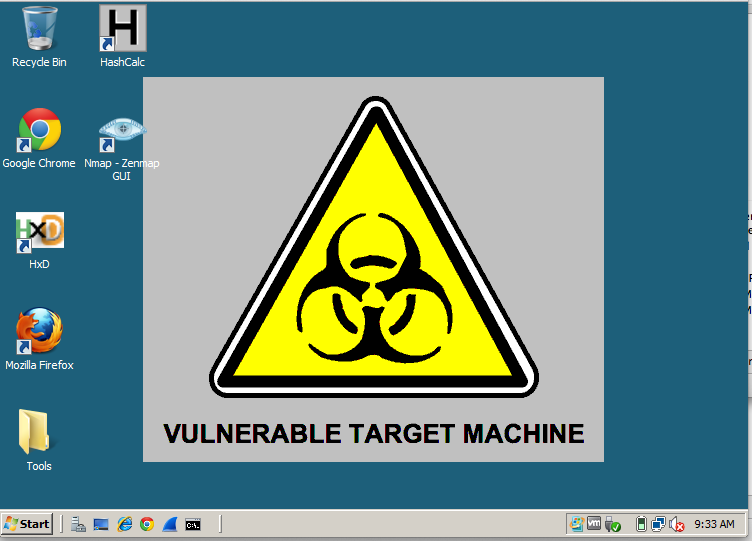
In the "Virtual Machine Settings" box, on the left side, click "Network Adapter".
On the right side, click "Bridged: Connect directly to the physical network", or "NAT" -- either mode will work for this project. Click OK.
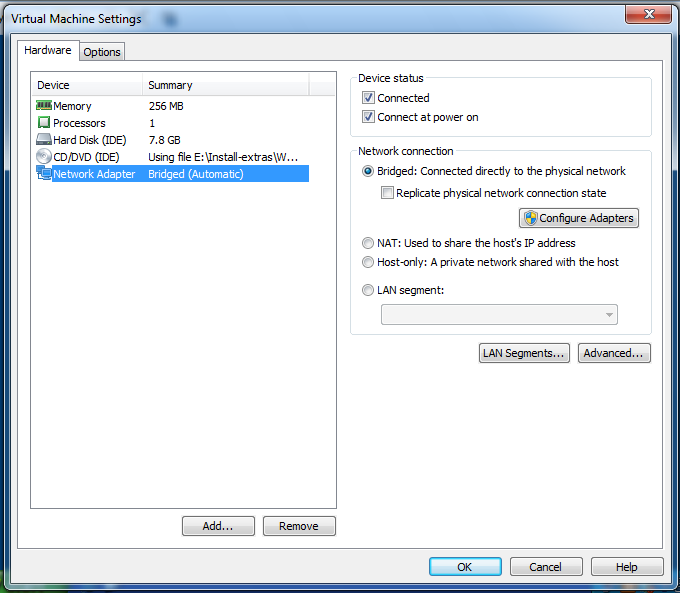
http://google.comIf you cannot open Google, which happens very often, try the troubleshooting steps listed below.
Troubleshooting a VMware Network Connection
- RESTART: Restart the virtual machine
- USE DHCP: In the virtual machine, click Start. In the Search box, type CONTROL NETCONNECTIONS and press Enter. Right-click "Local Area Connection" and click Properties. Double-click "Internet Protocol Version 4 (TCP/IPv4)" and make sure both the "Obtain an IP address automatically" and "Obtain DNS server address automatically" buttons are selected. Click OK. Click OK.
- REPAIR THE CONNECTION: In the virtual machine, click Start, Control Panel, Network Connections. Right-click "Local Area Connection" and click Repair.
- VMWARE BRIDGE PROTOCOL: In the Host machine, click Start and type "NETWORK CONNECTIONS" into the Search box. In the results, click "View network connections". Right-click "Local Area Connection" and click Properties. Make sure the "VMware Bridge Protocol" item is checked. Click OK.
- MAKE A NEW VIRTUAL MACHINE: When all these actions fail, which is very common, you need to discard the virtual machine and extract a fresh one from the original .7z file.
In the Command Prompt screen, type in IPCONFIG and press the Enter key.
Your IP address apears, with the Subnet Mask and Default Gateway, as shown below.
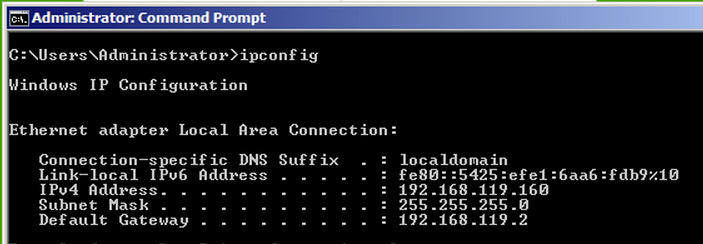
From your Windows Server 2008 desktop, click Start, right-click Network, and click Properties.
In "Network and Sharing Center", in the left pane, click "Manage network connections".
Right-click "Local Area Connection" and click Properties.
Double-click "Internet Protocol Version 4 (TCP/IPv4)".
Assign the same IP address, Subnet Mask and Default Gateway your saw in the IPCONFIG results, as shown below.
Set the DNS Server field to 127.0.0.1 and click OK.
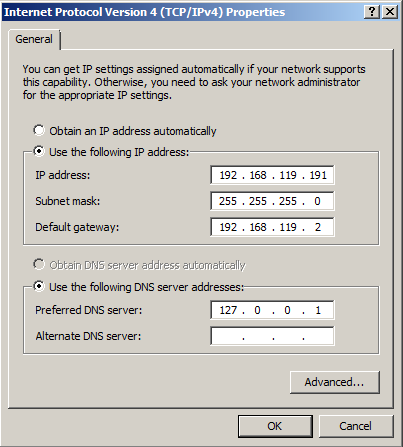
In the "Local Area Connection Properties" box, click OK.
On the left side, right-click Roles and click "Add Roles..." as shown below:
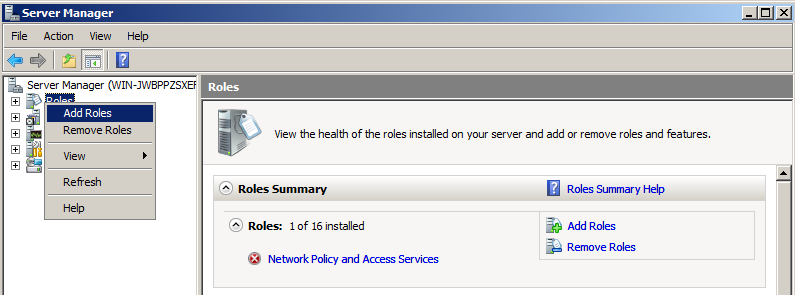
In the "Before You Begin" screen, click Next.
In the "Select Server Roles" screen, click the check box next to "DNS Server", as shown below:
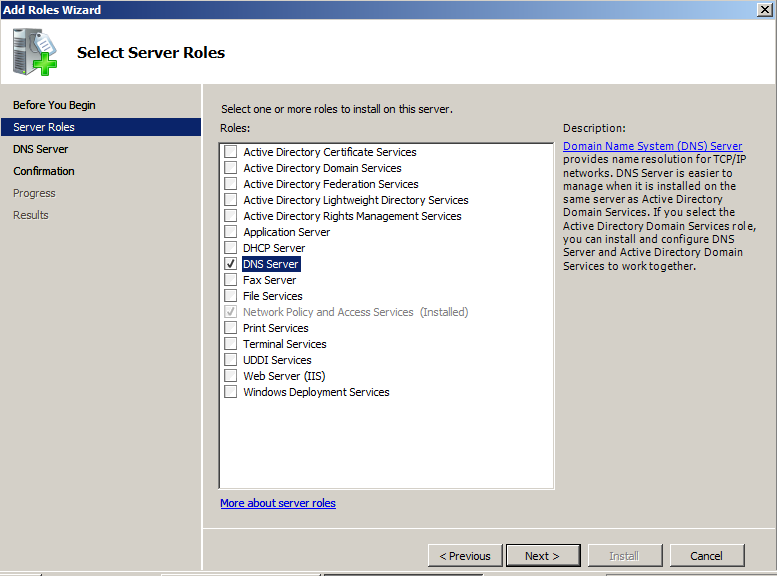
Click Next.
In the "Introduction to DNS Server" screen, click Next.
In the "Confirm Installation Selections" screen, click Install.
The "Installation Results" screen should show a green check-box with the message "Installation succeeded", as shown below:
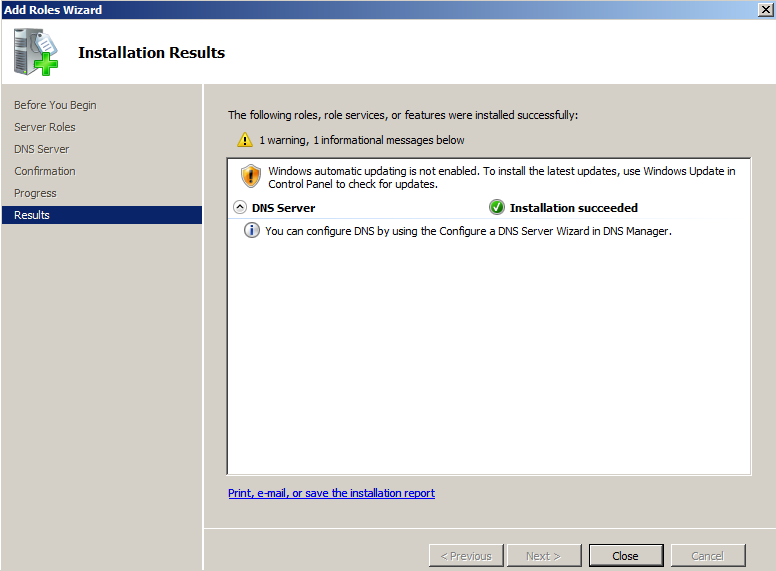
Click Close.
Execute this command:
NSLOOKUP CCSF.EDU

You have now completed the first part of Project 1. To prove it, you need to capture an image of the screen and email it to me.
Note the hand symbol on the image above: that indicates screen images that you must capture and turn in.
Click the taskbar at the bottom of your host Windows 7 desktop, to make the host machine listen to the keyboard, instead of the virtual machine.
Press the PrintScrn key in the upper-right portion of the keyboard. That will copy the whole desktop to the clipboard.
YOU MUST SUBMIT A FULL-DESKTOP IMAGE FOR FULL CREDIT!
On the host machine, not the virtual machine, click Start.
Type mspaint into the Search box and press the Enter key.
Click in the untitled - Paint window, and press Ctrl+V on the keyboard. The desktop appears in the Paint window.
In the upper left corner of the "untitled - Paint" window, click the little blue square icon (it looks like a floppy disk, something people used to use long ago--you might never have seen one).
Save the document with the filename "YOUR NAME Proj 1a", replacing "YOUR NAME" with your real name.
To find the authoritative server for CCSF.EDU, from your Windows Server 2008 desktop, in a Command Prompt window, execute this command:
NSLOOKUP
At the > prompt, enter these two commands, pressing Enter after each one (be careful, the "set" command is case-sensitive):
set type=ANY
CCSF.EDU
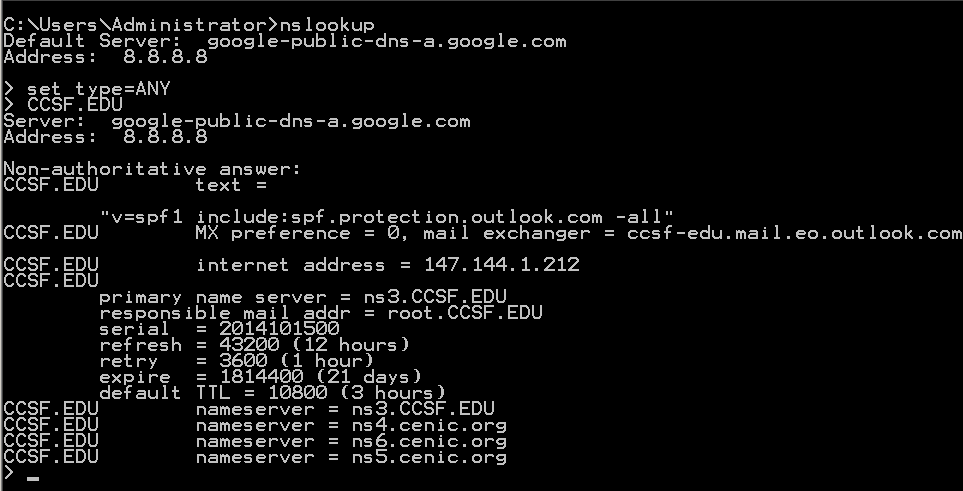
The results start with a message saying "Non-authoritative answer", because they came from your own local DNS server.
Notice the "primary name server" line in the middle of the output. That's the authoritative name server for the CCSF domain.
At the > prompt, execute this command:
CCSF.EDU ns3.ccsf.edu
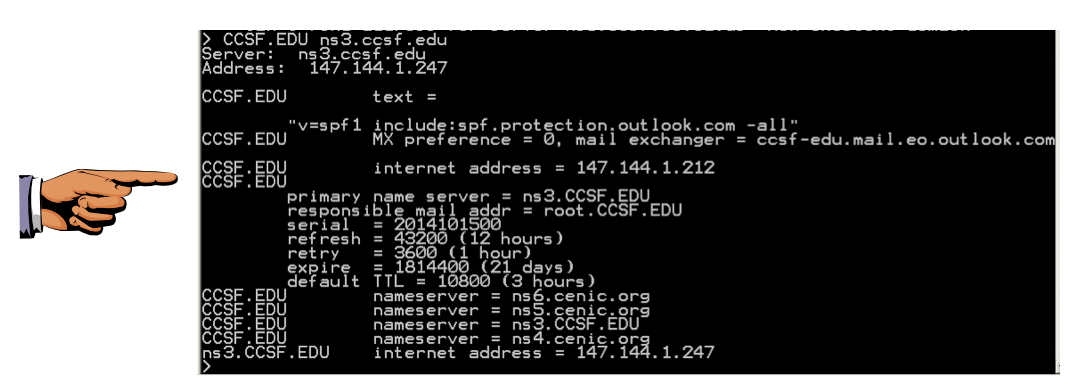
Press the PrintScrn key. Paste the image into Paint and save it with the filename "YOUR NAME Proj 1b", replacing "YOUR NAME" with your real name.
YOU MUST SUBMIT A FULL-DESKTOP IMAGE FOR FULL CREDIT!
quit
IPCONFIG /flushdns
IPCONFIG /displaydns
This is the Client Cache, used by the local Windows system. You'd see the same thing on any Windows machine, even if it is not a DNS server.
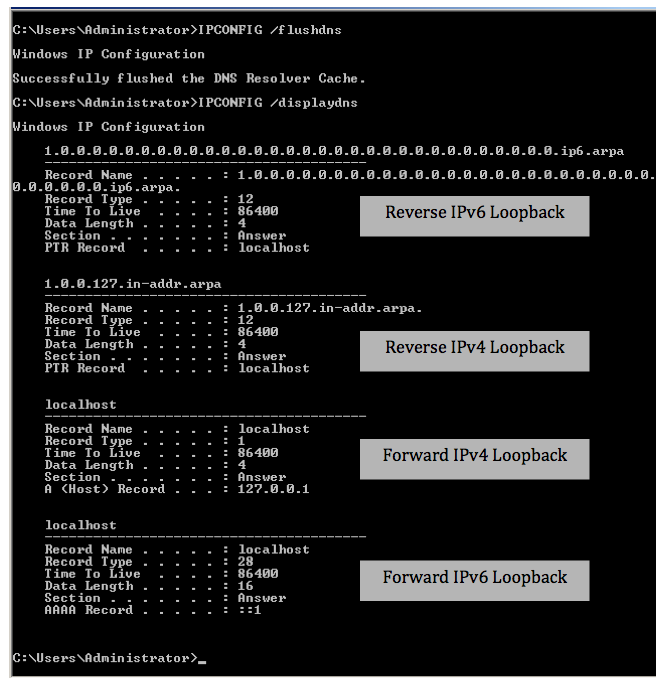
The four records above permit forward and reverse name resolution for both the IPv4 loopback address of 127.0.0.1 and the IPv6 loopback address of ::1, which can also be written 0000:0000:0000:0000:0000:0000:0000:0001.
Notice that the reverse records have a "Record name" which is the IP address backwards, followed by ".ipv6.arpa" or ".in-addr.arpa".
nslookup localhost
nslookup ::1
nslookup 127.0.0.1
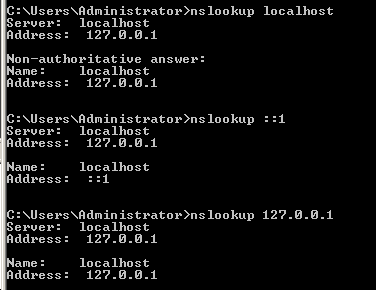
These commands perform:
ping ccsf.edu
ipconfig /displaydns
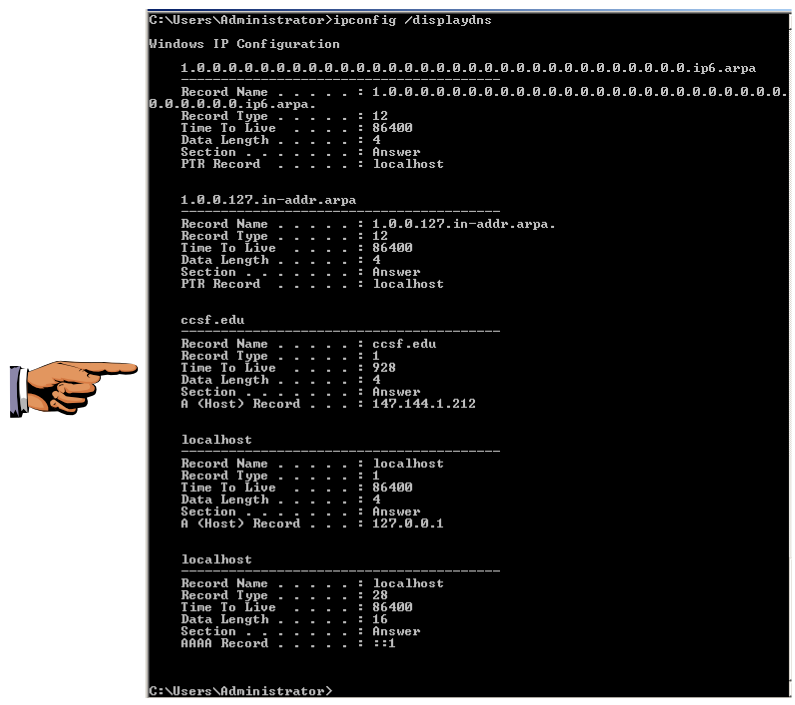
Press the PrintScrn key. Paste the image into Paint and save it with the filename "YOUR NAME Proj 1c", replacing "YOUR NAME" with your real name.
YOU MUST SUBMIT A FULL-DESKTOP IMAGE FOR FULL CREDIT!
The "DNS Manager" opens.
From the menu bar, click View, Advanced.
In the left pane, expand the server item (it starts with WIN).
Expand "Cached Lookups".
Expand .(root).
Expand EDU.
In the left pane, click CCSF.
Several entries appear, including ns3.ccsf.edu and 147.144.1.212, as shown below.
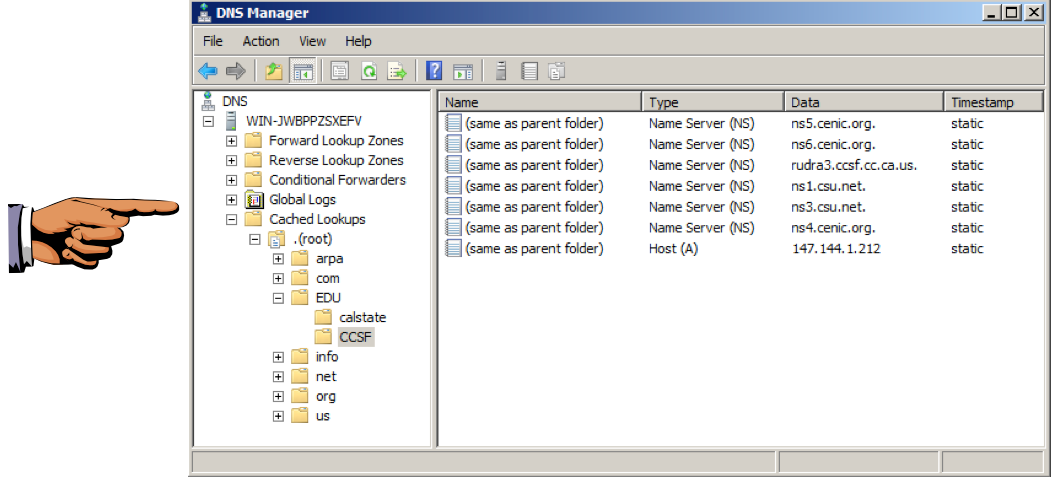
TROUBLESHOOTING
If there is no "Cached Lookups" item visible, right-click your server in the left pane and click View, Advanced.If there are no cached entries, they may have timed out. In a Command Prompt, ping ccsf.edu again. Then, in DNS Manager, click Action, Refresh.
Press the PrintScrn key. Paste the image into Paint and save it with the filename "YOUR NAME Proj 1d", replacing "YOUR NAME" with your real name.
YOU MUST SUBMIT A FULL-DESKTOP IMAGE FOR FULL CREDIT!
Send a Cc to yourself.